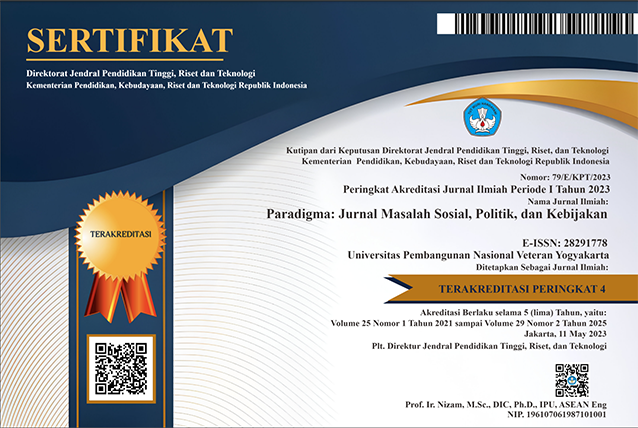Factors in Defending Australia’s Interests in the Pacific through Pacific ‘Step-up’ Foreign Policy Decision-Making in 2017-2018
DOI:
https://doi.org/10.31315/paradigma.v29i1.12508Keywords:
Pacific 'step-up', Kebijakan Luar Negeri, Australia, GeopolitikAbstract
Australia makes the Pacific region a fundamental interest to defend its national interests. This commitment was made by launching a Pacific 'step-up' foreign policy in 2018 based on the 2017 Foreign Policy White Paper. Foreign policy decision-making is caused by external factors and internal factors. These external factors stem from the growing strategic competition between the United States and China in the Pacific as well as China's increasing influence that could shift Australia's influence as a traditional Pacific partner. Meanwhile, the internal factors stem from the perception of Australia's political elite towards the Chinese threat and public opinion that supports government intervention in the Pacific. The merger of external and internal factors prompted Australia to take action in 'balancing'. This is because the United States and China are partners in national interests, so the choice to establish relations with Pacific Island Countries (PIC) is the right choice. Meanwhile, the Australian government's efforts to counter the Chinese threat and the Australian Government's support for providing assistance to the Pacific helped drive the policy. The problem is studied by using the policy-making theory of Graham T. Allison and the concept of neoclassical realism to look at the process of Australian foreign policy-making related to changes in the rules-based order and domestic conditions of Australia. The method used in this study uses a qualitative approach. The results of this study show that Pacific ‘step-up’ foreign policy is capable of defending Australia's national interests
References
Allison, Graham T. (1969). Conceptual Models and the Cuban Missile Crisis. American Political Science Review. 63(3): 689-718. doi: 10.2307/1954423.
Allison, Graham T. (1971). Essence of Decision: Explaining the Cuban Missile Crisis. New York: Longman.
Blaxland, John. (2017). Strategic Balancing Act: Australia’s Approach to Managing China, the USA and Regional Security Priorities. Security Challenges. 13(1), 19-40.
Chan, Lai-Ha. (2020). Strategic Hedging: A “Third Way” for Australian Foreign Policy in the Indo-Pacific. National Bureau of Asian Research. pp. 87-112.
Chao, Cong. (2020, 24 Juni). US rated by Chinese people as biggest stumbling block in China-Australia relations: survey. Global Times. Diunduh dari https://www.globaltimes.cn/content/1192609.shtml.
China Power Team. (2024, 5 Maret). What Does China Really Spend on its Military?. Center for Strategic and International Studies (CSIS). Diunduh dari https://chinapower.csis.org/military-spending/.
Conley Tyler & Ivimey, S. (2015). Balancing Australia’s National Interests. Australia’s Trade, Investment and Security in the Asian Century. National University of Singapore. pp. 273-287. doi: 10.1142/9789814632874_0016.
Creswell, J. W. (2003). Research Design: Qualitative, Quantitative, and Mixed Method Approaches. 2 nd Ed. Thousand Oaks: Sage Publications.
Defence. (2018). 2017-18 Portfolio Budget Statement – Defence Portfolio. Diunduh dari https://www.defence.gov.au/about/accessing-information/budgets/budget-2017-18.
Defence. (2020). 2020 Defence Strategic Update. Diunduh dari https://www.defence.gov.au/about/strategic-planning/2020-defence-strategic-update.
Defence. (2023). National Defence: Defence Strategic Review 2023. Diunduh dari https://www.defence.gov.au/about/reviews-inquiries/defence-strategic-review.
Department of Foreign Affairs and Trade (DFAT). (2017). 2017 Foreign Policy White Paper. Diunduh dari https://www.dfat.gov.au/sites/default/files/2017-foreign-policy-white-paper.pdf.
Department of Foreign Affairs and Trade (DFAT). (2019, 7 Juni). Trade and Investment at a Glance (Austrade) 2019. 5 Juni 2024, diunduh dari https://www.dfat.gov.au/about-us/publications/trade-investment/trade-at-a-glance/trade-investment-at-a-glance-2019/Pages/default.
Graham, Euan. (2023). The end of the affair. Dalam Graham, Euan (1st Eds), Australia’s Security in China’s Shadow (pp. 13-26). London: The Adelphi Series.
Grigg, A & Lisa M. (2016, 3 September). Malcolm Turnbull under increasing pressure to be firm with China. Financial Review. Diunduh dari https://www.afr.com/policy/economy/malcolm-turnbull-under-increasing-pressure-to-be-firm-with-china-20160831-gr5rr7.
Himmer, Michal. (2023). Chinese debt trap diplomacy: reality or myth?. Journal of the Indian Ocean Region. 18(3), 250-272. doi: 10.1080/194808881.2023.2195280.
Kabutaulaka, Tarcisius. (2021). Mapping the Blue Pacific in a Changing Regional Order. Australia National University Press. pp. 41-70. doi: 10.22459/CA.2021.01.
Keen, Meg & Alan T. (2024, 31 Januari). Geopolitics in the Pacific Islands: Playing for advantage. Lowy Institute. Diunduh dari https://www.lowyinstitute.org/publications/geopolitics-pacific-islands-playing-advantage#references.
Li, Carol. (2022). The Belt and Road Initiative in Oceania: Understanding the People’s Republic of China’s Strategic Interests and Engagement in the Pacific. Center for Excellence in Disaster Management & Humanitarian Assistance, 1-19.
Liang, Xiao. (2022). What can we learn from China’s military aid to the Pacific?. SIPRI. Diunduh dari https://www.sipri.org/commentary/blog/2022/chinas-military-aid-pacific.
Lilford, Oliver. (2019). Australia’s Pacific ‘Step-Up’: A Legitimate Engagement? SDGIA Working Paper Series No. 13. University of South Pacific, 1-29.
Lowy Institute. (2017, 21 Juni). 2017 Lowy Institute Poll. 5 Juni 2024, diunduh dari https://www.lowyinstitute.org/publications/2017-lowy-institute-poll#heading-4148.33
Lowy Institute. (2019, 25 Juni). 2019 Lowy Institute Institute Poll 2019. 5 Juni 2024, diunduh dari https://www.lowyinstitute.org/publications/lowy-institute-poll-2019.
McLean, Wayne. (2016). Neoclassical realism and Australian foreign policy: understanding how security elites frame domestic discourses. School of Social Science. doi: 10.1080/14781158.2015.1112774.
Moore, Liam. (2024). A dysfunctional family: Australia’s relationship with the Pacific Island states and climate change. Australian Journal of International Affairs. pp. 1-20. https://doi.org/10.1080/10357718.2024.2316098.
Morris, D. (2019, 5 September). Australia’s Pacific “Step Up” Stumbles. Asia Global Online. Diunduh dari https://www.asiaglobalonline.hku.hk/australias-pacific-step-up-stumbles.
Neuman, W. L. (2014). Social Research Methods: Qualitative and Quantitative Approaches (7th ed.). Essex: Pearson Education, Ltd.
Parliament of Australia. (2017, 28 Maret). Australian foreign policy in 2017: a year of delivery?. 1 Juli 2024, diunduh dari https://www.aph.gov.au/About_Parliament/Parliamentary_Departments/Parliamentary_Library/FlagPost/2017/March/Australian-foreign-policy-2017.
Parliament of Australia. (2019). Export Finance and Insurance Corporation Amendment (Support for Infrastructure Financing) Bill 2019. 1 Juli 2024, diunduh dari https://www.aph.gov.au/Parliamentary_Business/Committees/Senate/Foreign_Affairs_Defence_and_Trade/EficBill2019/Report/section?id=committees%2Freportsen%2F024274%2F27240#footnote7target.
Parliament of Australia. (2022). Pacific islands – key issues. Diunduh dari https://www.aph.gov.au/About_Parliament/Parliamentary_departments/Parliamentary_Library/pubs/BriefingBook47p/PacificKeyIssues#:~:text=Australia%20has%20responded%20to%20China's,new%20security%20and%20development%20initiatives.
Pryke, J. (2019, 4 April). Budget 2019: The Race to the Bottom for Foreign Aid. The Interpreter. Diunduh dari www.lowyinstitute.org/the-interpreter/ budget-2019-aid-downward-trend.
Rose, Gideon. (1998). Neoclassical realism and theories of foreign policy. World Politics. 51(1), 144-172.
Searight, A. (2020, 8 Mei). Countering China’s Influence Operations: Lessons from Australia. Center for Strategic and International Studies (CSIS). Diunduh dari https://www.csis.org/analysis/countering-chinas-influence-operations-lessons-australia.
SIPRI. (2017). Military Expenditure Database. 5 Juni 2024, diunduh dari https://www.sipri.org/databases/milex.
Stake, R. E. (1995). The art of case study research. California: SAGE Publications, Inc.
Turnbull, Malcolm. (2017). Keynote address at the 16th IISS Asia Security Summit, Shangri-La Dialogue. Diunduh dari https://www.malcolmturnbull.com.au/media/keynote-address-at-the-16th-iiss-asia-security-summit-shangri-la-dialogue.
Varrall, Merriden. (2021). Australia’s Response to China in the Pacific: From Alert to Alarmed. Australia National University Press. pp. 107-141. doi: 10.22459/CA.2021.03.
Wallis, J & M. Wesley. (2016). Unipolar Anxieties: Australia’s Melanesia Policy after the Age of Intervention. Asia & the Pacific Policy Studies. 3(1), 26-37. doi: 10.1002/app5.114.
Wallis, Joanne. (2020). Strengthening Australia relationships with countries in the Pacific region. Australian. Diunduh dari https://www.aph.gov.au/DocumentStore.ashx?id=3e5c73e9-4a12-462d-b809-3fa047fa8ec1&subId=679921.
Wallis, Joanne. (2021, 3 November). Stepping-up With Australia’s “Pacific Family”. Australian Institute of International Affairs. Diunduh dari https://www.internationalaffairs.org.au/australianoutlook/stepping-up-with-australias-pacific-family/.
White House. (2017). National Security Strategy of the United States of America. Diunduh dari https://trumpwhitehouse.archives.gov/wp-content/uploads/2017/12/NSS-Final-12-18-2017-0905.pdf.
Wu, Yi. (2024, 30 Mei). China-Australia Relations: Opportunities, Challenges, and Latest Updates. China Briefing. Diunduh dari https://www.china-briefing.com/news/china-australia-bilateral-ties-opportunities-challenges-latest-updates/.
Zhou, H & Eugenio C. (2018, 9 Februari). The Chinese banking system: Much more than a domestic giant. VoxEu. Diunduh dari https://cepr.org/voxeu/columns/chinese-banking-system-much-more-domestic-giant.
Downloads
Published
How to Cite
Issue
Section
License
The manuscript submitted to Paradigma: Jurnal Masalah Sosial, Politik, dan Kebijakan journals are released under the license of Creative Commons Attribution-Non Commercial- ShareAlike (CC BY SA) if and when the article is accepted for publication.
We declare that:
- This paper has not been published in the same form elsewhere.
- It will not be submitted anywhere else for publication prior to acceptance/rejection by this Journal.
- A copyright permission is obtained for materials published elsewhere and which require this permission for reproduction.
Retained Rights/Terms and Conditions
Authors retain all proprietary rights to the published works, such as (but not limited to) the following rights:
- Copyright and other proprietary rights relating to the article, such as patent rights,
- The right to use the substance of the article in own future works, including lectures and books,
- The right to reproduce the article for own purposes,
- The right to self-archive the article
The right to enter into separate, additional contractual arrangements for the non-exclusive distribution of the article's published version (e.g., post it to an institutional repository or publish it in a book), with an acknowledgment of its initial publication in this journal Paradigma: Jurnal Masalah Sosial, Politik, dan Kebijakan



